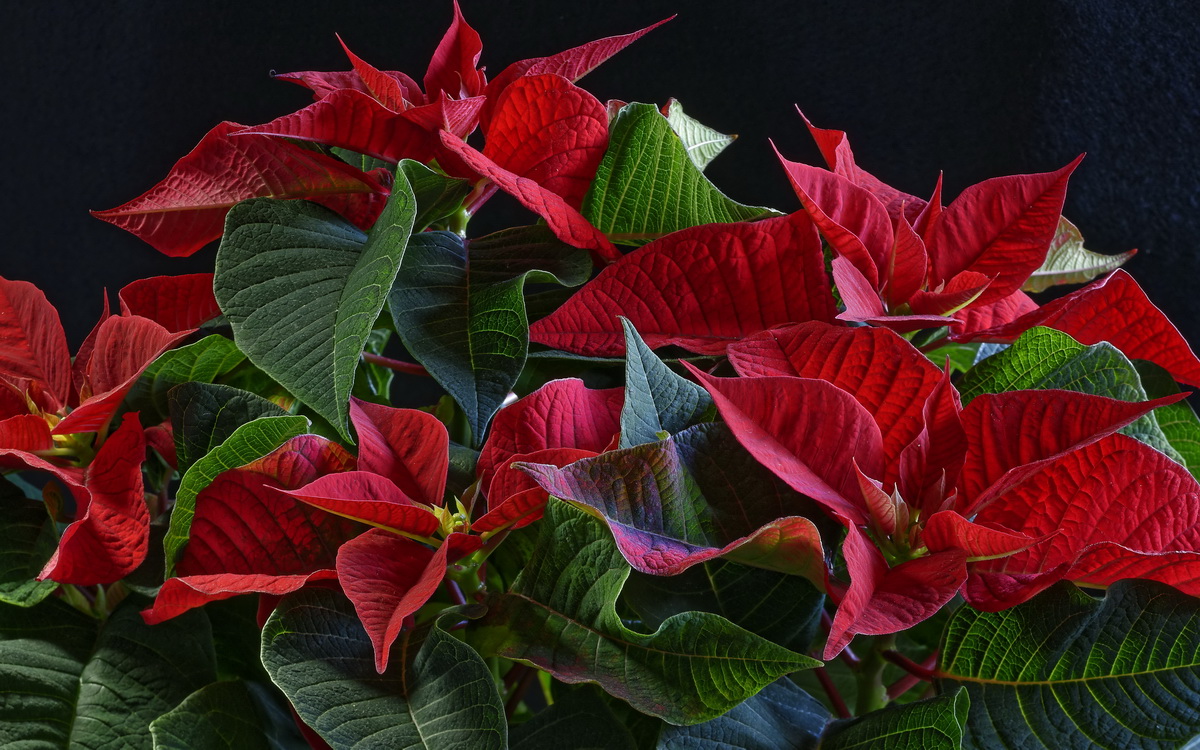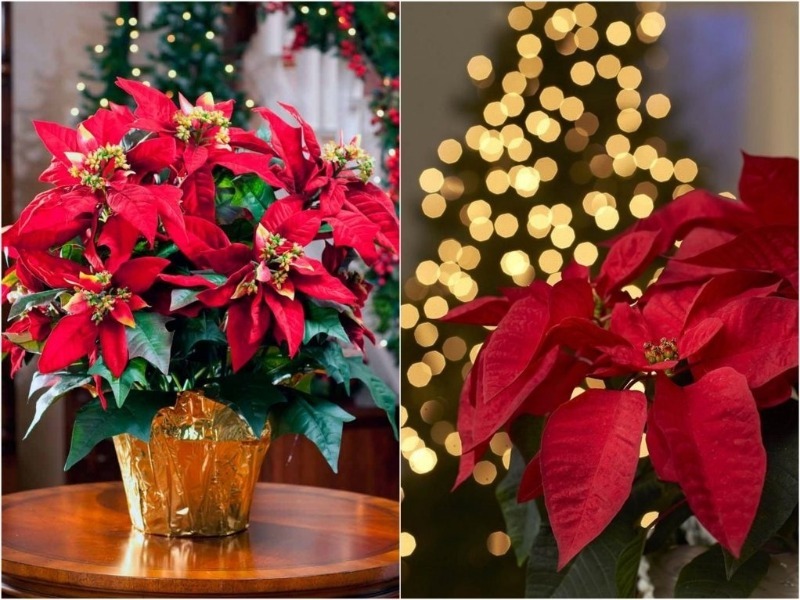The Christmas Star, also known as Poinsettia, is a deciduous, perennial, shrubby houseplant with the red flowers of the Euphorbia group. The bracts give the plant a gorgeous look - large contrasting leaves at the very top of the shoots. These leaves can be pink, bright red, cream, yellow, and even spotted and bicolored. They remain on poinsettia for only a few weeks.
The flowers of a room Christmas star themselves are rather inconspicuous - green-yellow, short in length. The family includes quite a few varieties, this is:
- poinsettia is the most beautiful;
- spherical poinsettia;
- poinsettia brilliant;
- poinsettia large-horned;
- poinsettia Mil.
At home, both annual and biennial plants are cultivated.
Content
Flower Christmas star: description
 The Christmas star is an indoor plant with a short daylight hours, therefore this plant blooms with a little light in the winter. The stems are branched, erect, the leaf is rich green or bicolored - with a cream frame, with an orange-red petiole. The flowers are green-yellow, small, collected in inflorescences. Flowering lasts 3-7 weeks.
The Christmas star is an indoor plant with a short daylight hours, therefore this plant blooms with a little light in the winter. The stems are branched, erect, the leaf is rich green or bicolored - with a cream frame, with an orange-red petiole. The flowers are green-yellow, small, collected in inflorescences. Flowering lasts 3-7 weeks.
The finest poinsettia (euphorbia) is a shrub from the euphorbia group that grows naturally in Mexico. If you break a leaf of this plant, then a white juice will come out, which can cause allergies and irritation of the skin.
To keep the previously purchased indoor poinsettia in its most attractive form before Christmas, place it on a sunny windowsill, organize a constant temperature (approximately 21 degrees during the day and at least 15 degrees at night). Water the plant as the soil dries up so that water passes through the substrate and out of the drainage hole, but do not let the plant "float". Also, avoid drafts and any cold effect (for example, the touch of a leaf to cold glass on a window), since the plant is quite vulnerable and quickly sheds foliage if there is any sign of discomfort.
Flower story christmas star
Beautiful Christmas poinsettia flower has a rather long history... The first connoisseurs of this plant were the Aztecs, who called this flower cuetlaxochitl. From his red flower beds they obtained a natural dye for fabrics and cosmetics, and they used the white sap of the plant to treat fever.
The population of America saw the most beautiful euphorbia with the help of the botanist and Dr. J.R. Poinsett, (1778-1852). He was the first US ambassador to Mexico under the direction of President Madison. Poinsett's greatest passion was plants and botany. The first time he saw the euphorbia in Mexico in 1827, Poinsett immediately sent samples to his greenhouse in Greenville, where he then began to propagate the plant and send samples to various botanical gardens.In 1831, this flower got into commercial production and quickly became popular under the name poinsettia (translated into Russian, the name stuck like poinsettia). The tradition of buying poinsettia for Christmas has passed from the States to Europe.
Christmas flower care
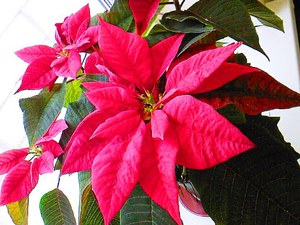 This houseplant prefers diffuse and bright lighting, without direct rays of the sun. In the summer, poinsettia should be exposed to bright areas and fresh air (garden, loggia), protecting from direct sunlight, wind and rainfall. If it is not possible to rearrange the flower to fresh air in the summer, then you need to periodically ventilate the room.
This houseplant prefers diffuse and bright lighting, without direct rays of the sun. In the summer, poinsettia should be exposed to bright areas and fresh air (garden, loggia), protecting from direct sunlight, wind and rainfall. If it is not possible to rearrange the flower to fresh air in the summer, then you need to periodically ventilate the room.
To make the plant bloom for the New Year, from the beginning of October, you need to maintain a light regime. With the onset of twilight, you need to cover the bush with a dark package that does not let light through and remove it only in the morning or rearrange the flower in a dark place (the bush should be in the dark for 11-15 hours a day). This must be done for two months, after which the usual care takes place. Longer lighting, including artificial lighting, inhibits the formation of inflorescences and enhances foliage development... After a couple of weeks, after using the "short day" tactic, the bush forms buds of inflorescences. With the subsequent stay of the plant in this mode, bright bracts appear.
- The optimum temperature during rest is 11-15C.
- The air temperature in winter during flowering is at least 13-15C.
- The rest of the year, the plant does well at normal room temperatures of 17-24C.
Watering
Watered abundantly in the summer, as the top layer of the earth dries up. In winter, it is watered moderately, without creating strong moisture and drying out the soil - it must be constantly slightly damp.
Rest time
Poinsettia has a pronounced rest time. After the descent of the bracts, the plant goes on a short rest (about 2 months). At this time you need significantly reduce watering (preventing the earth from completely dry out), keep the poinsettia in a moderately warm room (11-15C).
Air humidity
The plant needs high humidity. The leaf of a flowering bush should be periodically sprayed with settled, soft and warm water. The poinsettia pot can be placed on a pallet with wet peat or expanded clay.
Top dressing
Periodic groundbaiting after the dormant time has passed will help the flowering begin. It is necessary to feed once every two weeks from spring to autumn with full-fledged mineral dressings of normal concentration.
Transfer
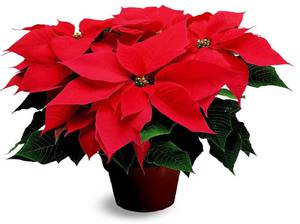 The plant is transplanted every year in the spring (usually in April). In March, the branches are cut off by a third (leaving 4-6 strong buds on the bush) and the bush is rearranged on a sunny windowsill in a warm room. Watered with lukewarm water... When the leaves are formed, the poinsettia is transplanted into a pot, a little more than the past.
The plant is transplanted every year in the spring (usually in April). In March, the branches are cut off by a third (leaving 4-6 strong buds on the bush) and the bush is rearranged on a sunny windowsill in a warm room. Watered with lukewarm water... When the leaves are formed, the poinsettia is transplanted into a pot, a little more than the past.
The soil is used slightly acidic (pH approximately 6). The substrate can be made from leaf and clay-turf soil, sand and peat in a ratio of 2: 3: 1: 1. Good drainage will be required. After transplanting, the bush is rearranged in a warm place (about 21C) and begins to spray and water well. Soon, new shoots will begin to form on the plant. It is necessary to leave only a few (4-5 strongest) shoots, and cut off the rest. Cut shoots can be used as cuttings for flower propagation.
Maintain a compact and neat look in the shrub: make sure that the branches of the flower do not grow naked and very long. If this happens, then you can cut the shoots a little again to make the bush lush.
Reproduction
The Christmas star is propagated in early summer or spring apical cuttings... The prepared cutting must have at least 5 internodes. When cutting off the cuttings, white juice is released - latex, it can be removed with blotting paper, after which the slices are covered with ground charcoal.If latex comes out very abundantly, then you need to place the cuttings for a short time in cool water, and then cover with charcoal. This protects the cuttings from rot, since the sap of the plant clogs the vessels, prevents the cut from tightening, which can infect the plant.
You need to root the cuttings in water or in a loose and damp substrate - sand and peat, taken in equal parts. For more active rooting, growth stimulants (for example, heteroauxin) can be used. The temperature is maintained at approximately 25-27C, the container with cuttings is periodically sprayed and ventilated. After root formation (usually after a month), young bushes are transplanted into small pots. The bush from the cutting is cut, this contributes to better branching.
Security measures
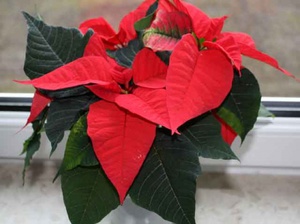 Poinsettia juice is poisonous and can cause violations such as:
Poinsettia juice is poisonous and can cause violations such as:
- vomiting;
- contact dermatitis;
- diarrhea;
- irritation of the stomach.
In sensitive people, this shrub can cause pollen allergies. All manipulations with the plant must be done very carefully, preferably with gloves. Upon completion of work, hands should be well washed with soap.
Possible difficulties:
- Due to the strong waterlogging of the earth, or with weak watering, foliage can wither or fall off.
- Thrips cause the formation of wavy elongated spots on the leaves and their twisting.
- Significant harm is caused to the flower by insects, which cover the leaves with honeydew.
- In low light, the leaves wither and fall off.
- Leaves may drop unexpectedly without any signs of wilting in the wind or very cold temperatures.
- Drying and yellowing of the leaves and even the death of the bush are a sign of spider mite infection.
- In very dry and hot indoor air, the edges of the leaves turn brown or yellow, and the flowers fall off.
Poinsettias can grow naturally at home only on the south side, in dry and hot rooms. The plant cannot withstand temperatures less than + 11-14 degrees... Poinsettia need a lot of moisture in summer and spring, but watering should be minimal in winter and autumn. Also, the plant does not tolerate changes in temperatures and drafts.
Poinsettia care tips
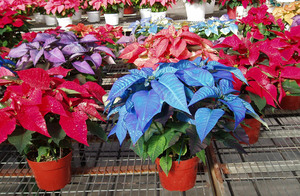 In order for the plant to bloom and the bracts to receive a bright color, the poinsettia must be grown in conditions similar to natural during flowering. It is very difficult to create these conditions for a plant, close to the climate of the regions of natural growth. Therefore, people far from gardening prefer to acquire a plant every year in winter (at the budding stage) and then throw it out when the flowering is over and bright bracts will fall off.
In order for the plant to bloom and the bracts to receive a bright color, the poinsettia must be grown in conditions similar to natural during flowering. It is very difficult to create these conditions for a plant, close to the climate of the regions of natural growth. Therefore, people far from gardening prefer to acquire a plant every year in winter (at the budding stage) and then throw it out when the flowering is over and bright bracts will fall off.
But many gardeners “do not raise their hand and do not allow the soul” to throw out the living faded bush, which brought them a lot of joy - as it may well bloom and grow further for a long time. If you also want to try to keep your Christmas star until next year out of kindness, for the sake of saving money and interest, then here are some tips on how to do it.
After the plant has bloomed, you need to shorten its branches in half and rearrange the bush in a dry room with a temperature of at least + 11-14 degrees for a couple of weeks with occasional watering. In May, the branches of the bush must be cut again (leaving about 16 cm in length from the ground), transplant the flower into a larger pot, rearrange it in a sunny and warm room and water it periodically.
Soon shoots will begin to form on the bush, you need to leave only a few of the strongest ones, and remove the rest of the shoots.
Short daylight hours are an important factor for the formation of bright and beautiful bracts and poinsettia flowering. In December, inflorescences should form on the plant, then you can rearrange the flower on a sunny windowsill. If proper care has been taken, then at Christmas a grateful poinsettia will be even more magnificentthan before, will color the bracts and begin flowering.
Whether you have grown your poinsettia with your own hands or bought a houseplant from the store, it will certainly be the center of attention at Christmas. Do not forget to place the container with the red flower in a beautiful planter and place the bush in a prominent place. You will probably decide to place your poinsettia in the middle of the festive table and surround it with candles or other festive attributes. Traditionally, Christmas comes to any home with poinsettia.
